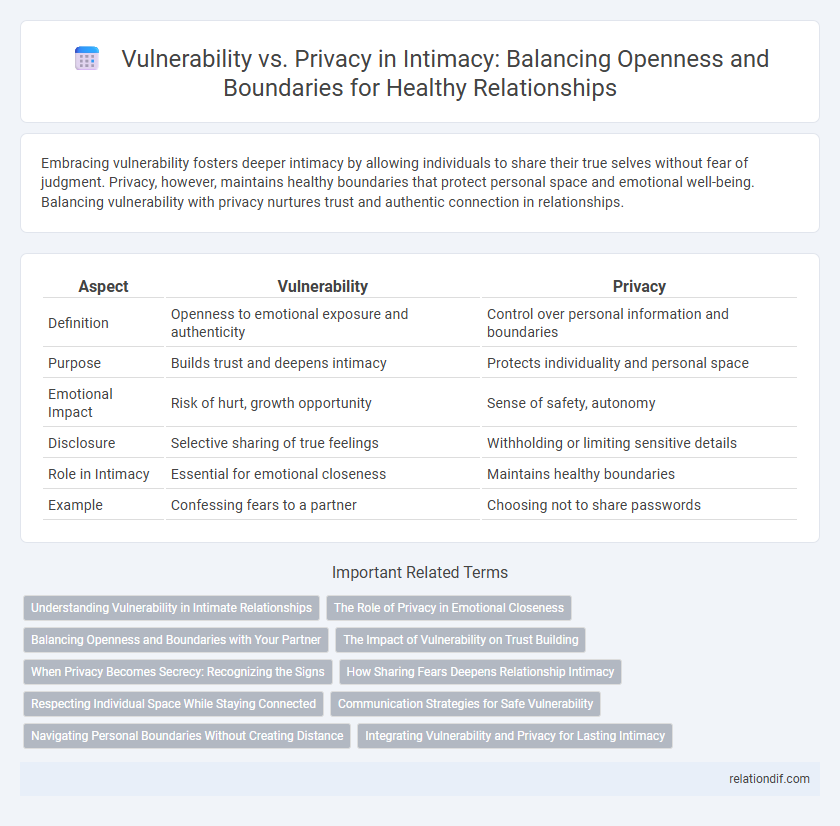Embracing vulnerability fosters deeper intimacy by allowing individuals to share their true selves without fear of judgment. Privacy, however, maintains healthy boundaries that protect personal space and emotional well-being. Balancing vulnerability with privacy nurtures trust and authentic connection in relationships.
Table of Comparison
| Aspect | Vulnerability | Privacy |
|---|---|---|
| Definition | Openness to emotional exposure and authenticity | Control over personal information and boundaries |
| Purpose | Builds trust and deepens intimacy | Protects individuality and personal space |
| Emotional Impact | Risk of hurt, growth opportunity | Sense of safety, autonomy |
| Disclosure | Selective sharing of true feelings | Withholding or limiting sensitive details |
| Role in Intimacy | Essential for emotional closeness | Maintains healthy boundaries |
| Example | Confessing fears to a partner | Choosing not to share passwords |
Understanding Vulnerability in Intimate Relationships
Understanding vulnerability in intimate relationships involves recognizing the balance between openness and self-protection. Vulnerability fosters emotional closeness by allowing partners to share fears, desires, and imperfections without judgment. Maintaining privacy ensures personal boundaries are respected, creating a safe space where trust can deepen and intimacy can flourish.
The Role of Privacy in Emotional Closeness
Privacy plays a critical role in fostering emotional closeness by creating a safe space where individuals feel secure to share their vulnerabilities without fear of judgment or exposure. Maintaining personal boundaries allows trust to deepen, enabling authentic exchanges that strengthen intimate connections. The balance between openness and privacy helps partners nurture intimacy while preserving individual identity and autonomy.
Balancing Openness and Boundaries with Your Partner
Balancing openness and boundaries with your partner requires understanding the delicate interplay between vulnerability and privacy, fostering trust without compromising personal space. Sharing emotions and experiences builds intimacy, while respecting each other's need for privacy creates a safe environment for authentic connection. Establishing clear communication and mutual respect helps maintain this equilibrium, enhancing emotional closeness and relationship satisfaction.
The Impact of Vulnerability on Trust Building
Vulnerability fosters deeper trust by allowing individuals to share authentic emotions and experiences, revealing true selves beyond superficial interactions. Embracing vulnerability enhances emotional intimacy, encouraging reciprocal openness that strengthens relational bonds. Maintaining a balance between vulnerability and privacy is critical to ensure trust without compromising personal boundaries or emotional safety.
When Privacy Becomes Secrecy: Recognizing the Signs
Privacy becomes secrecy when individuals intentionally withhold critical information that impacts trust and emotional connection in a relationship. Signs include frequent avoidance of key topics, inconsistent explanations, and defensive reactions when questioned about personal matters. Recognizing these behaviors helps maintain healthy intimacy by distinguishing protective boundaries from harmful secrecy.
How Sharing Fears Deepens Relationship Intimacy
Sharing fears in intimate relationships fosters vulnerability, which acts as a catalyst for deeper emotional connections and trust. Vulnerability allows partners to reveal their true selves beyond surface-level interactions, promoting empathy and mutual understanding. This openness contrasts with privacy boundaries, where selective sharing maintains individuality but may limit the depth of intimacy achieved.
Respecting Individual Space While Staying Connected
Balancing vulnerability with privacy is essential for healthy intimacy, as it fosters trust without compromising personal boundaries. Respecting individual space allows partners to maintain their autonomy while cultivating emotional closeness. Open communication and mutual understanding ensure that connection thrives alongside personal privacy.
Communication Strategies for Safe Vulnerability
Effective communication strategies for safe vulnerability emphasize setting clear boundaries while sharing personal feelings to maintain privacy and trust. Active listening and empathetic responses create a supportive space where individuals feel secure expressing emotions without fear of judgment or exposure. Using "I" statements and consistent check-ins help partners navigate disclosures thoughtfully, ensuring mutual respect and emotional safety.
Navigating Personal Boundaries Without Creating Distance
Navigating intimacy requires balancing vulnerability with privacy to maintain connection without causing emotional distance. Clear communication of personal boundaries helps partners share authentically while respecting individual limits, fostering trust and openness. Establishing mutual understanding around privacy safeguards emotional safety and deepens relational closeness.
Integrating Vulnerability and Privacy for Lasting Intimacy
Integrating vulnerability and privacy creates a balanced foundation for lasting intimacy by allowing individuals to share authentic emotions while maintaining personal boundaries. This approach fosters trust and deep connection without compromising self-respect or emotional safety. Prioritizing open communication and mutual understanding enables partners to navigate vulnerability and privacy effectively, strengthening their intimate bond over time.
Vulnerability vs privacy Infographic

 relationdif.com
relationdif.com